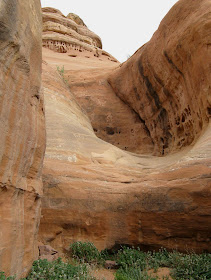 |
| What are all those holes?! That's tafoni, in Entrada sandstone in western Colorado. |
Tafoni, natural pockets in rock, range in size from little pits to huge cavities and come in an entertaining variety of shapes and patterns.
 |
| Elongate tafoni; 52-lb dog for scale. |

Sometimes there are tafoni within tafoni.
Above, nested tafoni ... not to be confused with nest in tafoni, below.

Tafoni form through weathering (decay) and erosion (transport away), though specific processes remain mysterious in many cases. This is another one of those wonderful geo-situations where educated speculation can run wild.
An observation -- tafoni are lined up parallel to bedding planes -- leads to an idea. Perhaps there was an interval of deposition that included coarser fragments, which fell out when exposed by erosion, opening tiny cavities that weathered with time.
Alas, around the corner there are diagonal patterns as well.
Whatever their origins, tafoni patterns are beautiful, fascinating, even mesmerizing, and for awhile I was completely lost in photographing them. Not a bad way to spend a morning.
 |
| I think I see something very interesting. |
 |
| Yep, let's go check it out. |
 |
| Black dog finds welcome respite from heat ... in tafoni. |












How cool, I see them everywhere here, now I know what they are called. Love looking at your pictures, thanks so much for sharing!
ReplyDeleteOn a different note, haven't found much on viral epidemics radiating diversity, other then the usual fossilized ERVs. What I did find was how viruses can affect gene regulation inside the cells... So I'll have a post coming up on that.
As for your question, maybe you can explain better what you had in mind? Sorry, so far my searches have come back with nothing... :-(